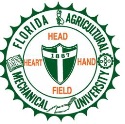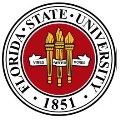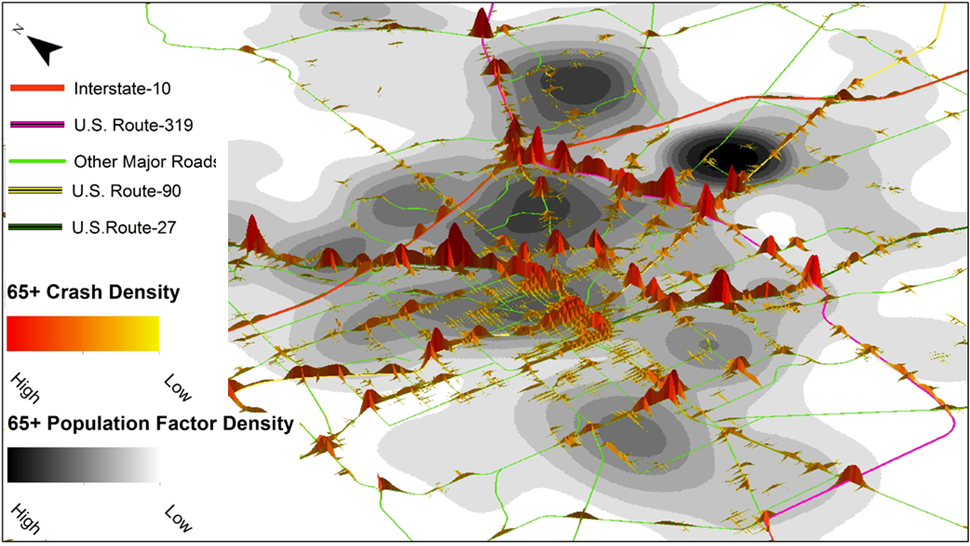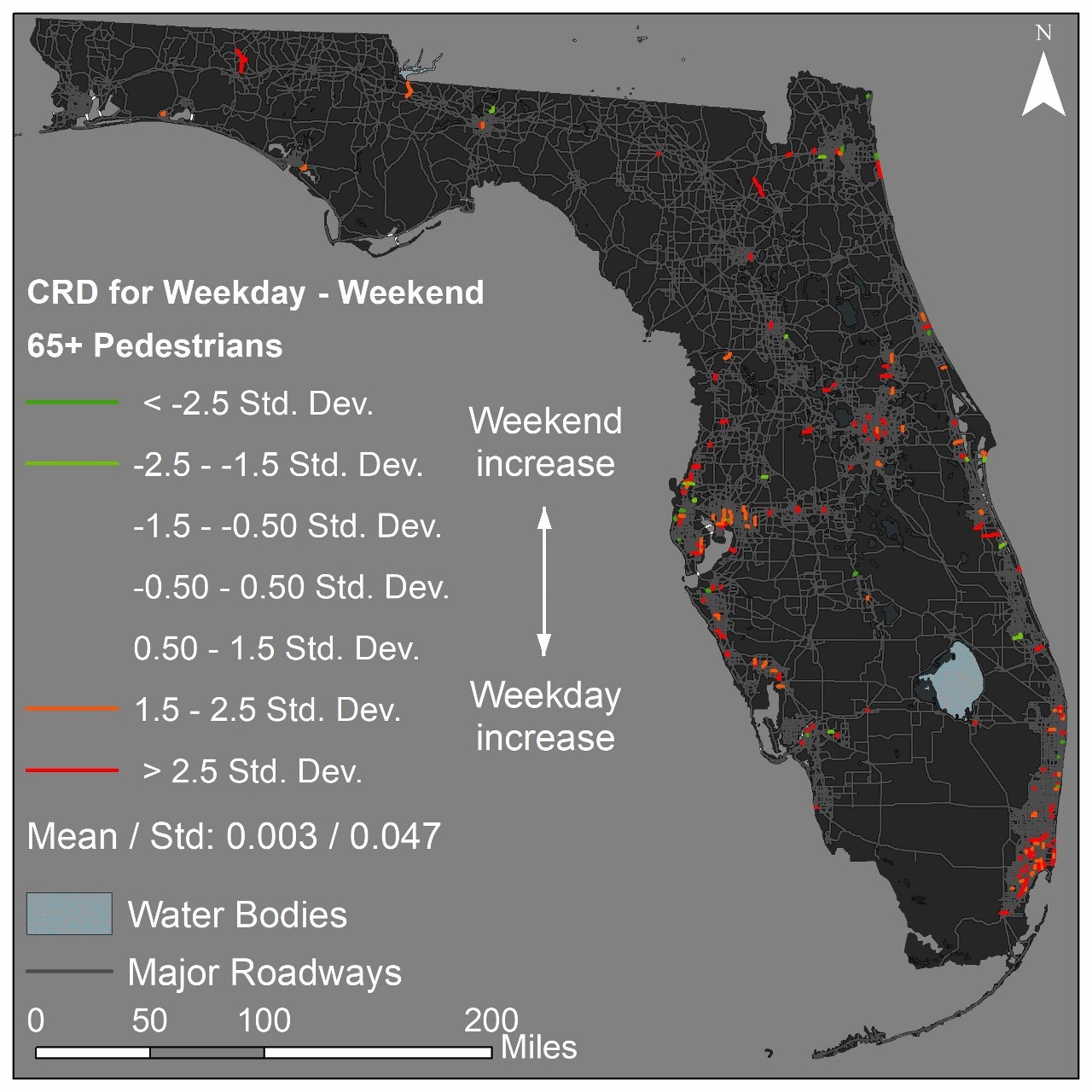

 Eren
Erman Ozguven
Eren
Erman OzguvenAssociate Professor
FAMU-FSU College of Engineering
Department of Civil and Environmental Engineering
Traffic Crash Analysis
Roadway
accidents claim more than 30,000 lives each year in the United
States, and they continue adversely affecting people’s well-being. This
problem
becomes even more challenging when aging populations are considered due
to
their vulnerability to accidents. This is especially a major concern in
Florida
since the accident risk is increasing proportionally to the population
growth
of aging Floridians. As such, this
research investigates the spatial and temporal patterns
of aging people-involved accidents using Geographical Information
Systems
(GIS)-based methods and statistical analysis. The
utmost importance is given to answering the following question: How do
the aging-involved crashes (drivers, passengers, bicylists and pedestrians) vary compared to crashes involving other age
groups?

Senior Crash Density and Population Density in the City of Tallahassee, Florida.
Vemulapalli, S., Ulak, M. B., Ozguven, E. E., Sando, T., Horner, M., Abdelrazig, Y., and Moses, R., "GIS-based Spatial and Temporal Analysis of Aging-involved Accidents: A Case Study of Three Counties in Florida", Applied Spatial Analysis and Policy", Volume 10, Issue 4, pp. 537-563, 2017.


Senior Crash Density and Population Density in the City of Tallahassee, Florida.
Vemulapalli, S., Ulak, M. B., Ozguven, E. E., Sando, T., Horner, M., Abdelrazig, Y., and Moses, R., "GIS-based Spatial and Temporal Analysis of Aging-involved Accidents: A Case Study of Three Counties in Florida", Applied Spatial Analysis and Policy", Volume 10, Issue 4, pp. 537-563, 2017.

Spatiotemporal Variations of 65+ Pedestrian-involved Crashes in Florida.
Ulak, M. B., Ozguven, E. E., Vanli, A.,Dulebenets, M., and Spainhour, L., "Multivariate Random Parameter Tobit Modeling of Crashes Involving Aging Drivers, Passengers, Bicylists and Pedestrians: Spatiotemporal Variations", Accident Analysis and Prevention, Volume 121, pp. 1-13, 2018.
Ulak, M. B., Ozguven, E. E., Vanli, A.,Dulebenets, M., and Spainhour, L., "Multivariate Random Parameter Tobit Modeling of Crashes Involving Aging Drivers, Passengers, Bicylists and Pedestrians: Spatiotemporal Variations", Accident Analysis and Prevention, Volume 121, pp. 1-13, 2018.
News
More...
More...
More...
More...
More...
More...
NSF Website...
Project Website...
Resilient Infrastructure and Disaster Response (RIDER) Center is established
New RIDER Center will serve as a technology hub for resilience and disaster research. The center aims to establish and develop emergency plans that fit the needs of both urban and rural communities.More...
New National Science Foundation Project: SCC-CIVIC: Rural Resiliency Hubs
The goal of this project is to study and evaluate the role of rural libraries as resiliency hubs with a focus on the interactions between community actors, population needs, environment, information, and infrastructure to foster disaster resilience in communities.More...
New National Science Foundation Project: Excellence in Research: Bending the Curve for Vulnerable Populations
This project takes a community-engaged, multi-disciplinary approach to address the pressing research problems for concurrently occuring hurricanes and pandemics, with a focus on the challenges facing vulnerable populations.More...
National Science Foundation Project: Cope-RCN: Resilient Rural Infrastructure
The objective of this project is to explore how to achieve adaptive capacity and resilience for Gulf coastal communities, which has the potential to extend to other rural communities in the U.S., and to foster a new understanding of the complex interactions among the key elements of community resilience in rural coastline areas.More...
Article in the Conversation: How Rural Areas Like Florida's Panhandle Can Become More Hurricane-ready?
It is extremely challenging to prepare for very fast Category 5 hurricanes like Hurricane Michael. But proactive planning and community-level decision making can ensure that no one is left without assistance.More...
National Science Foundation Project: Excellence in Research: Integrated Hazard and Traffic Modeling for Massive Evacuation in Florida under Uncertainty of Hurricane Track
This project integrates coastal hazard modeling with comprehensive evacuation modeling while considering the uncertainty of hurricane track. With the integration of these models and the capability to examine the interdependencies of the critical infrastructure, better dynamic evacuation models can be produced.More...
National Science Foundation Project: SCC-RCN: One Bridge at a Time: Bridging the Digital Divide for the Well-Being of Aging Populations in Smart and Connected Communities
The objective of this project is to develop a collaborative, multidisciplinary research platform and to study the relationship between Smart and Connected Communities (S&CC) and the built environment (e.g., varying urban densities and demographics), centered on creating S&CC that incorporate the aging population to improve the wellfare of growing aging population in the U.S.NSF Website...
Project Website...